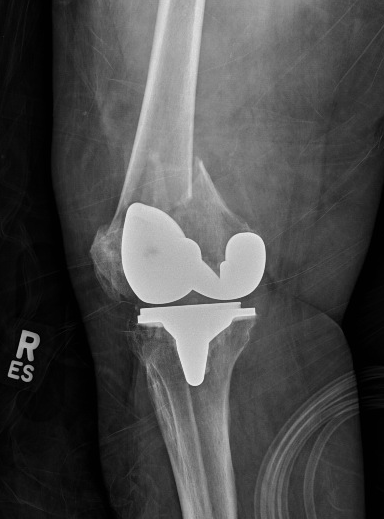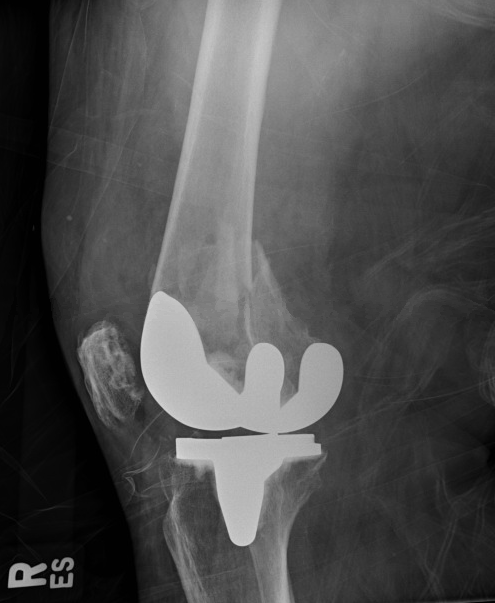[1]
Davies PS, Graham SM, Maqungo S, Harrison WJ. Total joint replacement in sub-Saharan Africa: a systematic review. Tropical doctor. 2019 Apr:49(2):120-128. doi: 10.1177/0049475518822239. Epub 2019 Jan 12
[PubMed PMID: 30636518]
Level 1 (high-level) evidence
[2]
Adie S, Harris I, Chuan A, Lewis P, Naylor JM. Selecting and optimising patients for total knee arthroplasty. The Medical journal of Australia. 2019 Feb:210(3):135-141. doi: 10.5694/mja2.12109. Epub 2019 Jan 18
[PubMed PMID: 30656689]
[3]
Naziri Q, Mixa PJ, Murray DP, Abraham R, Zikria BA, Sastry A, Patel PD. Robotic-Assisted and Computer-Navigated Unicompartmental Knee Arthroplasties: A Systematic Review. Surgical technology international. 2018 Jun 1:32():271-278
[PubMed PMID: 29611157]
Level 1 (high-level) evidence
[4]
Stilling M, Mechlenburg I, Jepsen CF, Rømer L, Rahbek O, Søballe K, Madsen F. Superior fixation and less periprosthetic stress-shielding of tibial components with a finned stem versus an I-beam block stem: a randomized RSA and DXA study with minimum 5 years' follow-up. Acta orthopaedica. 2019 Apr:90(2):165-171. doi: 10.1080/17453674.2019.1566510. Epub 2019 Jan 23
[PubMed PMID: 30669918]
Level 1 (high-level) evidence
[5]
Wang Z, Cheng X, Zhang Y, Zhang X, Zhou Y. Restoration of Constitutional Alignment in TKA with a Novel Osteotomy Technique. The journal of knee surgery. 2020 Feb:33(2):190-199. doi: 10.1055/s-0038-1677508. Epub 2019 Jan 16
[PubMed PMID: 30650441]
[6]
Minciullo L, Parkes MJ, Felson DT, Cootes TF. Comparing image analysis approaches versus expert readers: the relation of knee radiograph features to knee pain. Annals of the rheumatic diseases. 2018 Nov:77(11):1606-1609. doi: 10.1136/annrheumdis-2018-213492. Epub 2018 Aug 1
[PubMed PMID: 30068730]
[7]
Deng QF, Gu HY, Peng WY, Zhang Q, Huang ZD, Zhang C, Yu YX. Impact of enhanced recovery after surgery on postoperative recovery after joint arthroplasty: results from a systematic review and meta-analysis. Postgraduate medical journal. 2018 Dec:94(1118):678-693. doi: 10.1136/postgradmedj-2018-136166. Epub 2019 Jan 21
[PubMed PMID: 30665908]
Level 1 (high-level) evidence
[8]
Curtis GL, Chughtai M, Khlopas A, Newman JM, Sultan AA, Sodhi N, Barsoum WK, Higuera CA, Mont MA. Perioperative Outcomes and Short-Term Complications Following Total Knee Arthroplasty in Chronically, Immunosuppressed Patients. Surgical technology international. 2018 Jun 1:32():263-269
[PubMed PMID: 29611159]
[9]
Law RJ, Nafees S, Hiscock J, Wynne C, Williams NH. A lifestyle management programme focused on exercise, diet and physiotherapy support for patients with hip or knee osteoarthritis and a body mass index over 35: A qualitative study. Musculoskeletal care. 2019 Mar:17(1):145-151. doi: 10.1002/msc.1382. Epub 2019 Jan 24
[PubMed PMID: 30677219]
Level 2 (mid-level) evidence
[10]
McMahon SE, Doran E, O'Brien S, Cassidy RS, Boldt JG, Beverland DE. Seventeen to Twenty Years of Follow-Up of the Low Contact Stress Rotating-Platform Total Knee Arthroplasty With a Cementless Tibia in All Cases. The Journal of arthroplasty. 2019 Mar:34(3):508-512. doi: 10.1016/j.arth.2018.11.024. Epub 2018 Nov 23
[PubMed PMID: 30553560]
Level 3 (low-level) evidence
[11]
Sartawi M, Zurakowski D, Rosenberg A. Implant Survivorship and Complication Rates After Total Knee Arthroplasty With a Third-Generation Cemented System: 15-Year Follow-Up. American journal of orthopedics (Belle Mead, N.J.). 2018 Mar:47(3):. doi: 10.12788/ajo.2018.0018. Epub
[PubMed PMID: 29611846]


